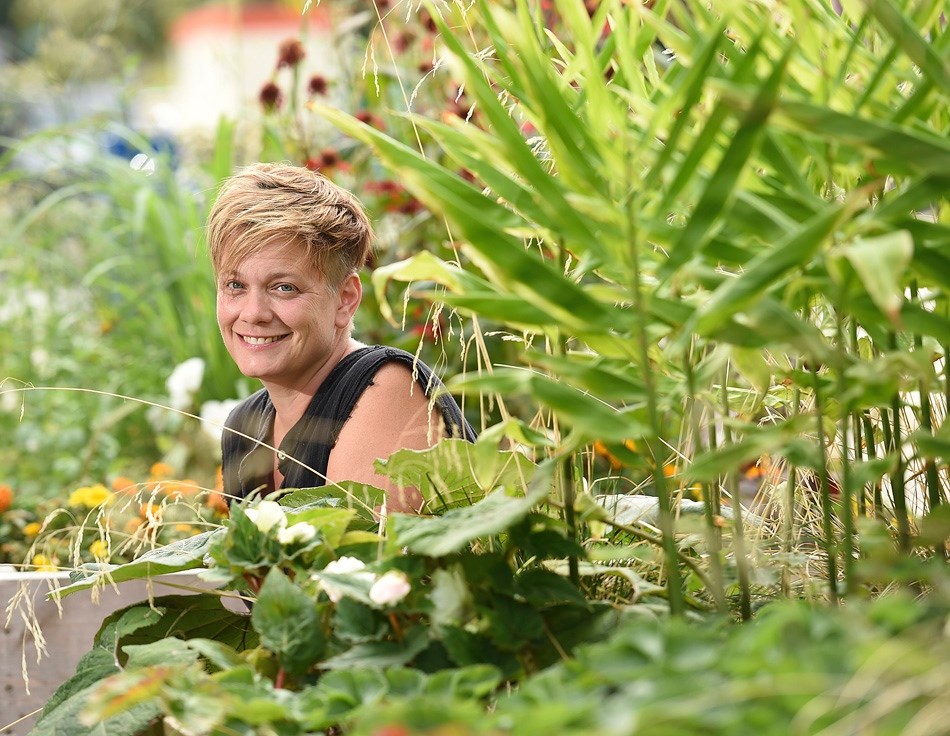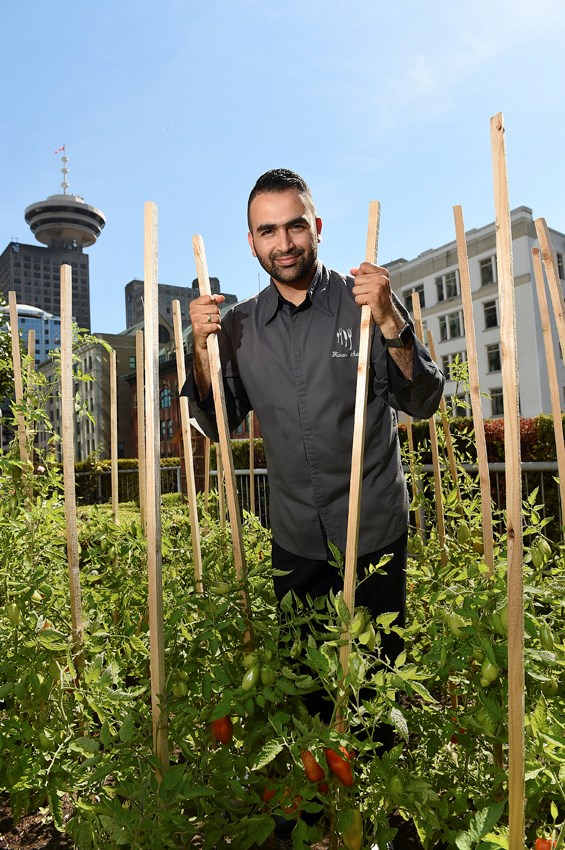The sun beats down on Karan Suri’s back as he stoops over to inspect his crop of San Marzano heirloom tomatoes. He steps carefully between the stalks on the soft soil, gently palming the bulbous red fruit. They are close, he says. A few more weeks of hot summer sun and they should be ready to harvest.
Around him, row upon row of verdant life grows, every plant lovingly tended for by Suri and his staff. There’s nasturtium flowers, fennel, garlic, mint, rosemary, even apple and fig trees, all growing in his modest plot.
Bees and butterflies dart playfully overhead, and if you squint your eyes and plug your ears, you might even forget that you’re in the middle of downtown Vancouver, some 40 feet above the rush-hour traffic below.
Suri is the executive chef at the Fairmont Waterfront, and his 2,100-sq.-ft. garden on the hotel’s third-floor terrace provides fresh produce and herbs for the hotel’s ARC restaurant and bar. The hotel even has it’s own apiary, where “Bee Butler” Michael King tends to a colony of more than 250,000 honeybees – the honey from which is used in everything from desserts to salad dressings to the honey lager brewed specially for the hotel by Whistler Brewing.
For Suri, the hotel’s garden and apiary present an opportunity to offer fresh, local produce, as well as provide a valuable educational experience for his staff and guests.
“For our junior cooks, it’s important for them to know where the produce comes from, and how much work goes into growing it,” he explains. “I want them to understand how a tomato grows. It’s about passion and inspiration. When you see a fresh product, you see the value in it.”
In doing so, he says his junior staff learns to respect the ingredients and they’re more thoughtful in how they use them.
The Fairmont Waterfront occasionally hosts dinners in the herb garden, and offers daily tours of the apiary.
“It’s not just a place to grow food, it’s a place for people to connect with food,” says Suri.
The garden also allows the hotel to reduce its environmental footprint. Food waste is used as compost in the garden, and by next year, the restaurant hopes to become 100 per cent waste-free.
The Fairmont Waterfront is far from alone in their efforts to grow produce on site, however. Nicholas Scapillati, executive director of FarmFolk CityFolk, says he’s seeing an increasing number of chefs and restaurant across the city develop their own gardens. Restaurants like Chill Winston and Grub on Main even have their own farm plots off site where they grow their own produce.
“We’re seeing chefs taking the local food trend to a whole new level,” says Scapillati. “I think it’s a great way for chefs to connect with our local food systems.”
FarmFolk CityFolk is a non-profit promoting and supporting community-based sustainable food systems, and hosts the annual Feast of Fields celebration of food.
Scapillati says the trend of restaurants growing their own ingredients really began in BC with the legendary Sooke Harbour House on Vancouver Island, which has operated a three-acre herb and edible blossom garden for the past 35 years (containing more than 200 plant varieties used in the restaurant’s ever-changing menu).
“They were really one of the originators of the movement,” he says.
While Scapillati doesn’t believe urban agriculture will ever replace traditional rural agriculture, he says it’s an important and growing part of our food system.
“The majority [of food] will always be grown in rural areas. Urban agriculture will never replace rural agriculture, but they do complement each other,” he says. “[Urban agriculture] does have its challenges. You can grow more than enough rosemary, but having micro greens [year-round] can be a little more difficult.”

For chef Andrea Carlson of Burdock & Co., those challenges can provide an opportunity for creativity.
One of the pioneers of the local food movement in Vancouver, Carlson became inspired to focus on local ingredients during her time at the Sooke Harbour House.
“Growing the botanicals was definitely something that was instilled in me working at the Sooke Harbour House on Vancouver Island,” she says. “It’s an incredibly inspired place. I learned a ton there, that ethos, and had an opportunity to experience on a daily basis the opportunities of the plants as they present themselves.
“Now it’s about the flower,” she continues, “then it’s the seed, then it’s about the fruit, then it’s the root. It’s not just about saying we have beets and tomatoes to work with. We have this entire world of potential from these plants, that’s what gets me excited when it comes to creating menus.”
Today, her restaurant at Main and East 11th has its own edible garden where Carlson and their staff grow unique herbs and plants, many of which aren’t available commercially in BC.
“We’re right in the city so we don’t have any extensive gardens,” she explains. “We just have a couple garden beds beside us, so we focus on growing botanical items that give us an opportunity to bring some unique flavours in.”
The two garden boxes stretch alongside the restaurant, and are overflowing with chrysanthemum greens, aromatic shiso herbs, burdock, fuki (bog rhubarb), Japanese myoga ginger, woodruff and tuberous begonia.
“No one else is growing that stuff, so that’s an opportunity to put on some stuff that we really love and is going to benefit us creatively and is totally unique,” says Carlson. “These are new flavours, textures and colours.”
She would like to expand her modest garden, but as is often the case with urban gardens, some of the more recognizable produce she grows has the tendency to “disappear.”
“What I would really love to do are some outside-the-box things like potted trees, but there’s always the fear of things getting stolen, which is a reality,” she says. “Just when you think the corn’s ready, the corn is gone. Someone completely decimated our rosemary.
“But it’ll bounce back.”
Feast of Fields
The 50th Feast of Fields event takes place Sept. 11 at Laurica Farm in Langley. For tickets and info, visit FeastOfFields.com



